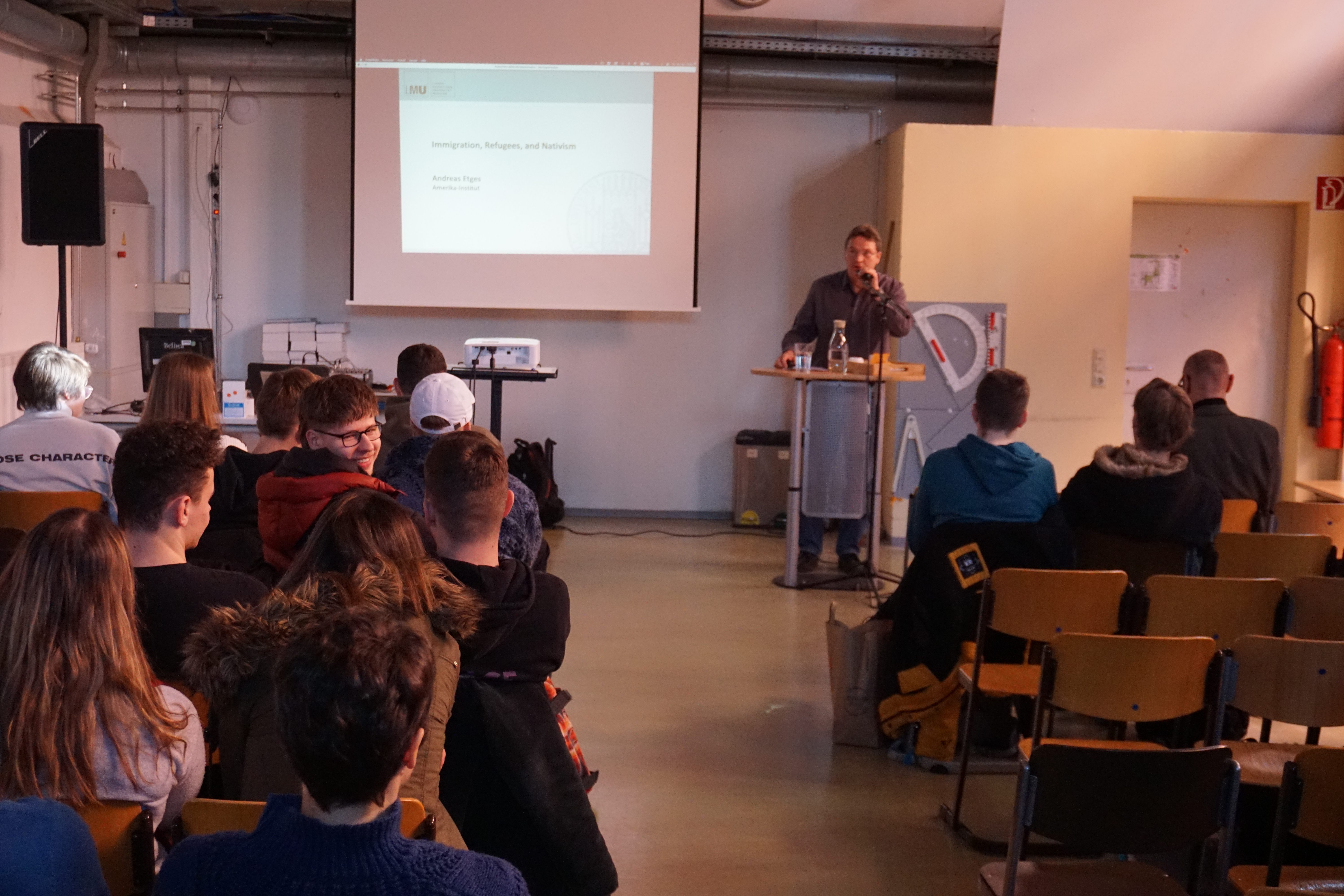Given today’s ever polarizing discourse around immigration in the United States, it’s worth taking a retrospective look at how we got here. After having been welcomed to our school and introduced by our headmaster, Gernot Helmreich, this is what Dr Etges of the Amerika-Institut of Ludwig-Maximilians-Universität München convincingly did and to which our 12th classes F12Sa, F12Tb and B12W listened attentively on February the 16th.
Tackling this issue this expert of American History began by referring to [We can begin at] the commonly used symbol for the US: The Statue of Liberty. Liberty and the unconstrained pursuit of happiness lies at the foundation of the American psyche. This driving force has appealed to many a people from around the world, which gives credence to the belief that America is a nation of immigrants in pursuit of said liberty and happiness.
Between 1892 and 1954, the number of immigrants reached circa 12 million with only about 2% being rejected. And until the First World War, Germans were substantially contributing to that number, adding over 5 million immigrants in total. The period preceding the Great War saw multiple waves of immigration due to socio-economic reasons (some of them persisting to this day). Irish immigrants had no choice but to immigrate due to the Great Famine of 1845, and Germans were inclined to immigrate to a more stable country given the political instability during the Vormärz era. In view of this, between the years 1820 and 1919, Europeans made up the biggest percentage of people who immigrated into America.
When mentioning the Great Irish Famine or Vormärz we are addressing so called push-factors, which is a factor that motivates a person to migrate away from their country or region of residence. General examples of push-factors are religious persecutions, which happened all over Europe at the time, especially concerning the Jewish community, political reasons, as we discussed above, economic decline in the country of the migrants, high taxes, overpopulation, marriage laws, military revival and avoidance of prison sentences.
Passing the Atlantic Ocean turned out to be an arduous task, at best. Poor migrants travelled to America on ships that were making their return voyage after having carried tobacco or cotton to Europe. The voyage took between 40 and 90 days, depending on the wind and weather.
Aside from the aforementioned Push-Factors, immigrants were further motivated to choose to emigrate to a certain place by so-called Pull-Factors, which ‘pull’ people towards a new home and include aspects like religious and political freedom but also socio-economic reasons. Chain migration, e. g. migrating to a country where a relative of yours resides, also made it easier for immigrants to integrate within the United States.
Germans were among the few immigrants which received special treatment from US companies. These companies were advertising to get more workers, and more often than not, also tricked people into immigrating, promising them higher wages, which they in the end did not receive. Fredrick Trump, ancestor of 46th US-President migrated from Germany in 1885 to avoid military service and lived with his sister until starting a career in real estate. Avoiding serving in the military meant a farewell to visiting Germany ever again without being arrested; a fate which many German immigrants faced. But that did not deter them from making the best of it: with Germans generally cluttering in the North East, they began doing their business in German and by the 2000’s 15% of the US population had German ancestry. This group of migrants usually did not play a huge part in politics and most even refused to identify as German during and after the Second World War.
The mid-19th century gave rise to a new sentiment of nativism, the idea that inhabitants born in a country are preferrable to immigrants, among the American population. Examples include anti-Catholicism, xenophobia towards Irish citizens and antisemitism. With time, these feelings seem to have faded because, as mentioned above, the big majority of Germans hid their ancestry during WW II due to substantial Anti-German Propaganda.
Today’s crises include an abundance of immigrants wanting to cross the southern border. The year 2022 marked the 2.4 million milestone of illegal crossings. Yet, deportations have been on a steady decline since Barak Obama’s presidency, with Obama’s government having deported around 300.000 people, Trump’s 200.000, and Biden’s 70.000. Considering the country’s foundation being based on immigration, and having followed Dr Etges’s overview this decline [development seems only natural] becomes intelligible also from an outsider’s perspective. Perhaps one day, the US and the world in general will find a better way to handle immigration, to replace of deportation.
Dr Etges closed his highly informative and vividly presented talk by addressing the questions of the audience who thanked him by warm applause for his third visit to our school, each according to invitations by Dr Streit.
a report by Roberto Matei Sofronia and Bianca-Maria Prodan of 12Sa
